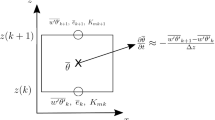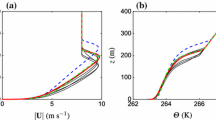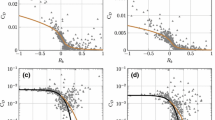Abstract
Two formulations of the stable atmospheric boundary layer are proposed for use in weather forecasting or climate models. They feature the log-linear profile near the surface, but are free from the associated critical Richardson number. The diffusion coefficients in the Ekman layer are a natural extension of the surface layer. They are locally determined using wind shear in one case and turbulent kinetic energy in the other. The parameterizations are tested in a one-dimensional model simulating the evolution of the nocturnal boundary layer with and without radiative cooling. Both formulations give very similar results, except near the top of the boundary layer where the transition to the free atmosphere is smoother with the wind shear formulation. A distinctive feature of these schemes is that they retain their simulating skill when resolution is reduced. This is verified for a wide range of situations. In practice, this means that there is no need for a large-scale model to have a level below 50 m or so.
Similar content being viewed by others
References
Blackadar, A. K.: 1962, ‘The Vertical Distribution of Wind and Turbulent Exchange in a Neutral Atmosphere’, J. Geophys. Res. 67, 3095–3102.
Delage, Y.: 1974, ‘A Numerical Study of the Nocturnal Boundary Layer’, Quart. J. R. Meteorol. Soc. 100, 351–364.
Delage, Y.: 1985, ‘Surface Turbulent Flux Formulation in Stable Conditions for Atmospheric Circulations Models’, Mon. Wea. Rev. 113, 89–98.
Delage, Y.: 1988, ‘The Position of the Lowest Levels in the Boundary Layer of Atmospheric Circulation Models’, to appear in Atmosphere-Ocean.
Garand, L.: 1983, ‘Some Improvements and Complements to the Infrared Emissivity Including a Parameterization of the Absorption in the Continuum Region’, J. Atmos. Sci. 40, 230–244.
Garratt, J. R., and Brost, R. A.: 1981, ‘Radiative Cooling Effects within and above the Nocturnal Boundary Layer’, J. Atmos. Sci. 38, 2730–2746.
Garratt, J. R.: 1982, ‘Observations in the Nocturnal Boundary Layer’, Boundary-Layer Meteorol. 22, 21–48.
Louis, J.-F.: 1979, ‘A Parametric Model of Vertical Eddy Fluxes in the Atmosphere’, Boundary-Layer Meteorol. 17, 187–202.
Louis, J.-F.: 1984, ‘ECMWF Forecast Model Physical Parameterization’. Research Manual 3, European Center for Medium Range Weather Forecasts, Reading, U.K.
Mailhot, J., and Benoit, R.: 1982, ‘A Finite-Element Model of the Atmospheric Boundary Layer Suitable for Use with Numerical Weather Prediction Models’, J. Atmos. Sci. 39, 2249–2266.
Troen, I., and Mahrt, L.: 1986, ‘A Simple Model of the Atmospheric Boundary Layer; Sensitivity to Surface Evaporation’, Boundary-Layer Meteorol. 37, 129–148.
Author information
Authors and Affiliations
Rights and permissions
About this article
Cite this article
Delage, Y. A parameterization of the stable atmospheric boundary layer. Boundary-Layer Meteorol 43, 365–381 (1988). https://doi.org/10.1007/BF00121713
Revised:
Issue Date:
DOI: https://doi.org/10.1007/BF00121713




